Culture, institutions and the long divergence
Journal of Economic Growth, v. 29, p. 1-40, 2024
Thierry Verdier.
Acesse o artigoDuring the medieval and early modern periods the Middle East lost its economic advantage relative to the West. Recent explanations of this historical phenomenon—called the Long Divergence—focus on these regions’ distinct political economy choices regarding religious legitimacy and limited governance. We study these features in a political economy model of the interactions between rulers, secular and clerical elites, and civil society. The model induces a joint evolution of culture and political institutions converging to one of two distinct stationary states: a religious and a secular regime. We then map qualitatively parameters and initial conditions characterizing the West and the Middle East into the implied model dynamics to show that they are consistent with the Long Divergence as well as with several key stylized political and economic facts. Most notably, this mapping suggests non-monotonic political economy dynamics in both regions, in terms of legitimacy and limited governance, which indeed characterize their history.
See also
The Value of Health Insurance: A Household Job Search Approach ( a sair)
Journal of Labor Economics, 2025
Gabriela Conti, Renata Narita, Rita Ginja.
Targeting in Adaptive Networks
Journal of Economic Theory, v. 228, 2025
Timo Hiller.
Tradeoffs and synergies for agriculture and environmental outcomes in the tropics (a sair)
Review of Environmental Economics and Policy, 2025
Fanny Moffette, Jennifer Alix-Garcia, Juliano Assunção, Prakash Mishra, Teevrat Garg.

